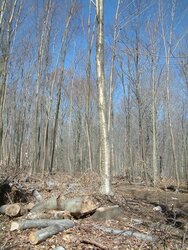Ninety percent of what I burn is beech. The balance is a combination of hard and soft maple and yellow birch. The YB is maybe 5% of my wood inventory.
The thing about yellow birch bark is that it contains wintergreen oil, which basically explodes when you get it near a flame. That's true whether the wood is dry or green, though you get more bang for the buck with dry bark, obviously. If you're ever lost or stranded out in the woods and need to build a fire, find a yellow birch tree and use some bark strips to get you started. Better than anything else you'll find. It also smells like incense when it burns.
Anyway, I noticed this morning that a few pieces of YB in the firebox of my boiler on startup has a dramatic impact on how long it takes to get gasification going. As in--immediately. It's volatile stuff.
YB grows over a fairly wide range, but it's mostly concentrated in the more northern areas. Those of us in New England, New York, parts of Pennsylvania, northern Wisconsin and the U-P have the most chance of finding it. Attached is a pic from the woodlot I'm thinning. In PA they call it "black birch" but it's basically the same stuff.
As a side note, YB is great firewood, but it grows really wet, so it takes about 2 years to dry out enough for good burning.
The thing about yellow birch bark is that it contains wintergreen oil, which basically explodes when you get it near a flame. That's true whether the wood is dry or green, though you get more bang for the buck with dry bark, obviously. If you're ever lost or stranded out in the woods and need to build a fire, find a yellow birch tree and use some bark strips to get you started. Better than anything else you'll find. It also smells like incense when it burns.
Anyway, I noticed this morning that a few pieces of YB in the firebox of my boiler on startup has a dramatic impact on how long it takes to get gasification going. As in--immediately. It's volatile stuff.
YB grows over a fairly wide range, but it's mostly concentrated in the more northern areas. Those of us in New England, New York, parts of Pennsylvania, northern Wisconsin and the U-P have the most chance of finding it. Attached is a pic from the woodlot I'm thinning. In PA they call it "black birch" but it's basically the same stuff.
As a side note, YB is great firewood, but it grows really wet, so it takes about 2 years to dry out enough for good burning.




 "Grey' seems to be a mis-nomer.
"Grey' seems to be a mis-nomer.